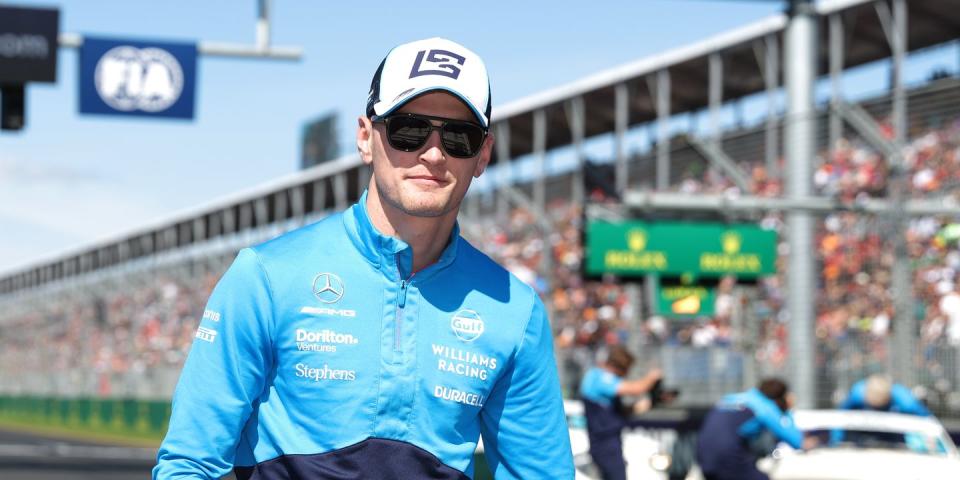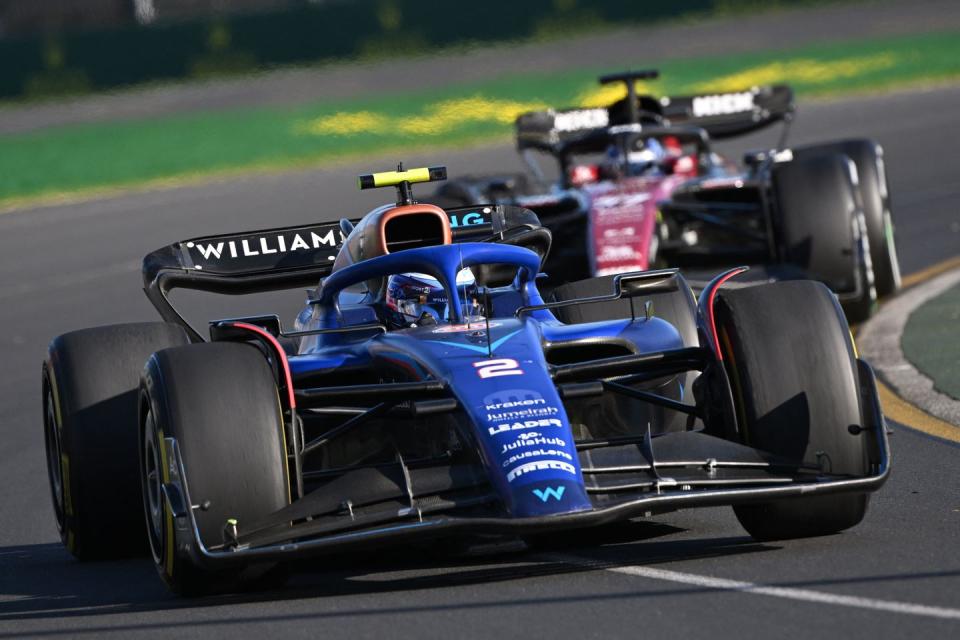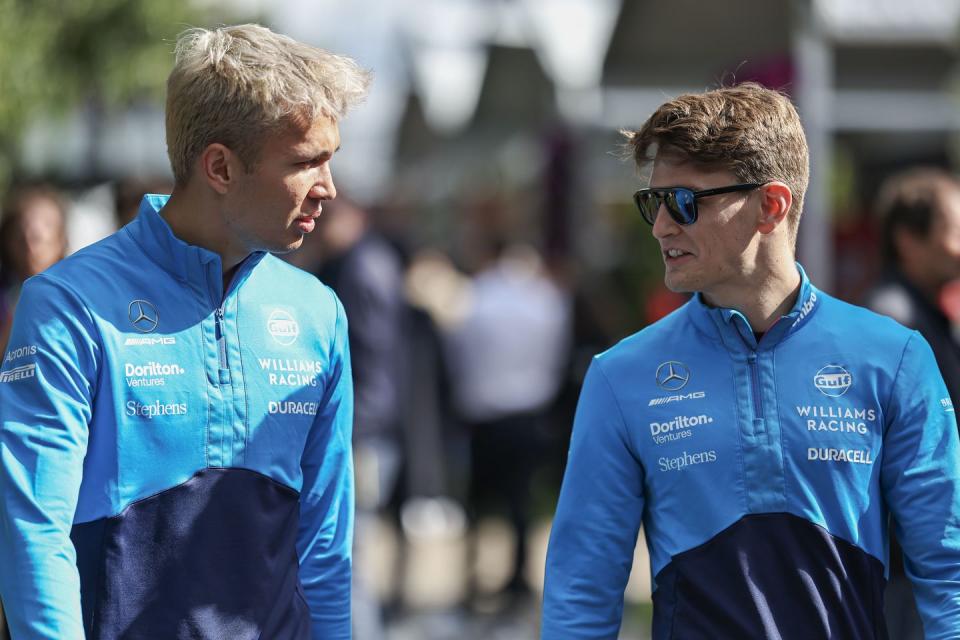F1 Report Card: American Formula 1 Rookie Logan Sargeant Earning Passing Grades

Logan Sargeant's journey with the Williams F1 team began in late 2021, when he was signed to its Driver Academy while in Formula 3.
In his first Formula 1 race in Bahrain, Sargeant finished 12th, two positions behind teammate and series veteran Alex Albon, and impressed onlookers with his mature approach.
Sargeant's first three races in Formula 1 have produced a typical rookie playbook: flashes of pace, blunders, and promise.
Logan Sargeant became America’s first full-time Formula 1 racer in a generation after signing for Williams for 2023. On paper, Sargeant’s start to 2023 has been mixed: P12, P16, P16.
Bahrain was excellent, Saudi Arabia was messy, Australia was underwhelming. Those are the mere blunt snapshots for a driver taking his first steps in the complex world of Formula 1 with a team that has been a perennial backmarker for years.
For Sargeant the journey with Williams began in late 2021, when he was signed to its Driver Academy while in Formula 3. Last season his Formula 2 displays brought him firmly into contention. In September Williams internally appointed Sargeant as a 2023 Formula 1 race driver, subject to the receipt of a Super License, which was duly confirmed at the 2022 Formula 2 finale in Abu Dhabi.
The post-season Abu Dhabi test in the 2022-spec Williams was the first outing of Sargeant the F1 racer, rather than F1 aspirant, and after that began a long winter of preparation.

“Usually Logan goes home for a good month or so (to Florida) but we cut that quite short,” says Ben Jacobs, an ex-Rugby Union player who has been Sargeant’s Performance Coach for the last six years. “If he hasn’t been at the gym, he’s been at the sim [at Williams’ factory], and he’s raised the bar himself to be honest. His mindset has been so purely focused on doing the best he can. I didn’t think he could get to that kind of level, as in the past it hasn’t been as hard, but the [last] off-season he’s done quite an impressive job.”
A week-and-a-half long training camp in Portugal, along with a brief trip home, broke up a relatively monastic winter that largely consisted of intense training in and around Sargeant’s base in London. That included the usual gym and cardio sessions, enhanced to prepare for the greater challenge of F1 versus F2, alongside games of paddle tennis and Pilates sessions. There were also regular trips to Williams’ factory at Grove for extensive meetings and lengthy simulator sessions.
“Over the winter he was very busy,” says Williams’ head of vehicle performance Dave Robson. “We spent a lot of time just talking to him about things—it’s not easy to spend a few hours with engineers when they’re boring the pants off a racing driver, but to be fair to him he listened, took it all in, and that gained an understanding of how we look at things.”

After a long winter without seat time, Formula 1 preseason testing was condensed into just three days in the FW45 in Bahrain, with track time split between Sargeant and teammate Alex Albon. That effectively meant just three four-and-a-half hour sessions to get up to speed.
“When he drove the car back in Abu Dhabi he was impressive and did a good job,” Robson explains.
“At the same time the pressure was off a bit, the car had a full season’s worth of information on it. So we were a bit nervous coming in with just 1.5 days of testing, it’s a big leap to go from a well understood car to ‘you’ve got to really contribute in testing’. But from the first moment he stepped in the car he didn’t put a foot wrong, he understands how to get the pace out of the car, he understands how to work with the engineers, he’s been exceptionally good. I think most impressive is the race he put together in Bahrain was really good. He probably deserves more recognition than he's got.”
In that first race in Bahrain Sargeant finished 12th, two positions behind Albon, and impressed onlookers with his mature approach.
“From the first laps of testing, immediately you could see that the pace was there,” said Williams team principal James Vowles, speaking in Saudi Arabia. “I was a little bit reticent in wondering whether it would take him a little bit of time to get used to it. It’s your first Grand Prix. The pressure on your shoulders is enormous and he took it in his stride. He was three-wide through Turn 1. Normally in your rookie race, that ends up in disaster and he just dealt with it, with enormous amounts of maturity, and from then onwards, and I'm sure as you'll see, throughout the year, he'll step forward.”
Sargeant, Vowles believes, has “this young, fiery passion” and “while he hasn’t got the experience Alex brings to the team he wants every millisecond you can get out of the car.”
Sargeant himself “had no expectations” pre-Bahrain and just went in “and drove, to see where that left me and to give myself a baseline.”
“It’s mainly just trying to get comfortable to the point where everything becomes second-nature and all of these… all these things just become natural rather than thinking about them and taking away mental capacity.”

Working closely with Sargeant has been race engineer Gaetan Jego.
“Every driver will be quite different, so you have to learn their personality,” said Jego, who previously worked with Nicholas Latifi.
“It has gone pretty smoothly—he has frustration he needs to manage sometimes, but it’s critical that the confidence is important. It’s important how much the driver will trust what you say, take the info, doesn’t second guess it and move on—so far, so good. That went well, he’s good with that, he doesn’t try to overthink things. If someone tells him this is the way it is and he believes that person, that makes life easy.”
Jego believes Sargeant initially “maybe tried to copy/paste a bit his relationship from F2” before realizing the significantly larger resources of F1 teams. “He was trying to get his information from me but now he understands to talk to the strategist, the PU engineer, the tire guy, to his mechanics, to people from design.”

That frustration Jego refers to came to the fore in Saudi Arabia. An unfortunate lap time expulsion for a marginal track limits breach led to a spiraling effect that wrecked Sargeant’s Q1, leaving him last on the grid, which consequently compromised the race.
“I think mainly it is just dealing (with it) when the pressure is really wound up and you make a fairly trivial mistake,” says Robson on the intense F1 spotlight. “It’s having the experience to know it’s not the end of the world, you don’t have to go out and force it. That just comes with experience to just take a big deep breath, put it out of your mind, and just crack on. I’m sure there’ll be other racing incidents that come up, but again, you just need the experience—how do you deal with these other 19 Formula 1 drivers at the same time.”
Sargeant adds that he has “always been self-critical, as when you see what you could have got out of it and what you did doesn’t align, it doesn’t feel very nice,” and Jego concurs that learning to deal with such setbacks is vital.
“I think he has high standards,” says Jego. “He wants do to really well, he really wants to succeed in F1. After quali in Jeddah, it was hard to take as he could have done better.
“What he needs to learn is also the F1 weekend format is quite different to F2. And he never started last in his whole career, and in Jeddah he started last and that caught him by surprise—so (there are) things that are new to him being in F1 and he has to expose himself to that.”
Saudi Arabia was followed by a quiet weekend in Australia, not aided by a Friday practice stymied by an electrical glitch, which culminated in a messy accident with Nyck de Vries at the chaotic restart—by far the least competitive of the three events to date considering Albon’s pace. But it is a long season, and it has been a typical rookie playbook: flashes of pace, blunders, and promise. Formula 1 is only three rounds into a 23-event calendar—and keeping Sargeant in peak physical and mental condition is a key element.
“Starting from Abu Dhabi [2022] going all the way through to testing, then having a huge season of his first F1 [season], with all the media, with traveling, going to Grove—it’s two hours there and back from London—they are huge commitments,” says Jacobs.
“Fatigue will play a part during the year for sure—it’s his first F1 year.”
Jacobs has a “daily plan, monthly plan, three-monthly plan” mapped out along with a yearly strategy to keep his charger as fresh as possible. Sargeant and Mercedes’ George Russell—who spent three years at Williams—share a management group, meaning tips have been exchanged from past lessons, while Jacobs has also bounced ideas off other trainers in Formula 1.
“Me and him have a good relationship,” says Jacobs. “I can tell what he needs when he needs it, that kind of stuff.”
Sargeant still has 20 Grands Prix remaining in his rookie season and has been encouraged by the overall start.
“Generally the first races have been a steep but good learning curve,” he says. “I’m getting more comfortable with the car. I’m ahead of where I expected to be but of course never satisfied, I want to keep improving and find more and more speed, but that’s all to come.”
Jego agrees that “the big thing is he knows he can be quick in an F1 car. Last year when he drove in the free practice sessions there were a lot of pressure of ‘can I do it?’ and he’s been showing so far that he can. Now he just wants to put the weekend together, show pace at the right time, then score points—that’s probably the next thing for him, but he doesn’t have the pressure of ‘am I good enough?’ He knows he has the pace.”
Sargeant’s performance so far has already provided “more hope of doing something, with more excitement for the garage crew,” according to Jego as the side of the Williams garage that struggled recently with Latifi “is more in the mix again, so it’s been a lot of fun”, as potential top 10s loom into view.
Overall though, as dull as it sounds, the bigger picture is keeping his head down and methodically adding to his knowledge bank.
“I’m looking forward to ticking off the next few races, getting those under my belt,” said Sargeant, who is eager to race in his native US for the first time in Miami in May. “I need to build more experience, and (then have) a strong run through Europe—getting to the circuits I know well to maximize what we have. I knew there’d be struggles—there still are going to be many struggles to come—but I believe the good days will outweigh those.”
Jego is confident that this is merely the very start of a lengthy Formula 1 career for the 22-year-old.
“It’s hard to say (what Sargeant can achieve) as I think it will depend on what we can achieve as a team as well. But I’m sure he’s here to stay in F1.”

 Yahoo Autos
Yahoo Autos 